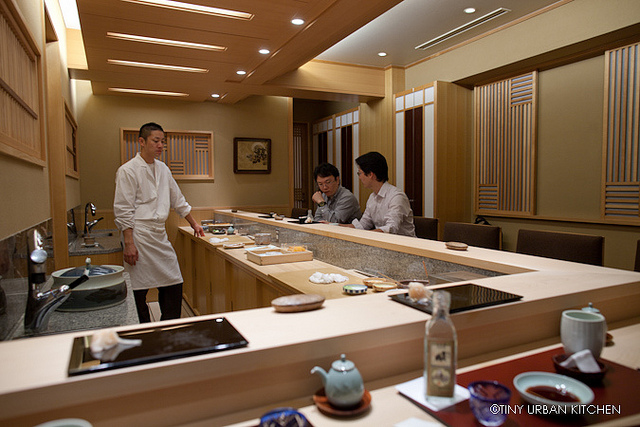
This is part 7 of my latest travel series: Post Quake Japan. Other posts in this series: Kago, Daisan Harumi, Tempura Kondo, Sushi Mitani, Inakaya, and Aronia de Takazawa.I never expected ever to dine at Sushi Mizutani.
It wasn’t for lack of trying, that’s for sure.
In my last two trips to Japan, I tried to book a reservation at this tiny, 8-seater, 3-star Michelin sushi bar. Twice, I was rejected. Rumor has it that you have to book at least 2 months in advance, maybe 3 to be safe. Typically (purely a result of my disorganized propensities), I don’t start planning my trips until about 2 weeks before leaving. At that pont, it’s usually too late to reserve the really popular places.
Surprisingly and sadly, I had no trouble reserving a coveted sushi bar spot this time around. The massive earthquake back in March had all but scared foreigners away. No one was coming to Japan, and therefore this sushi master’s table was actually open.
Available for those like me to partake.
Seriously, a once-in-a-lifetime opportunity.
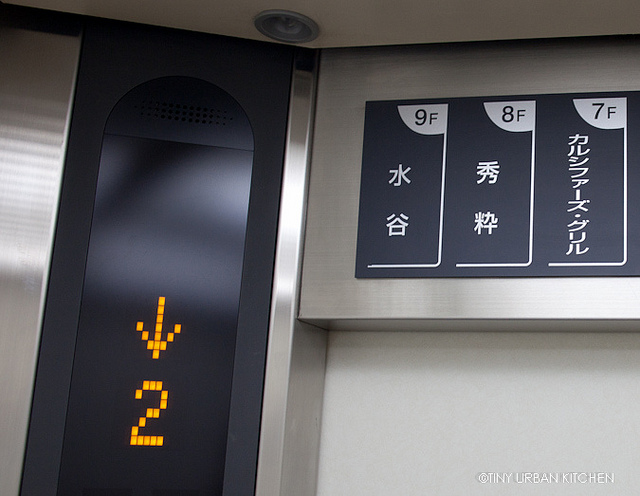
First things first. This place is not easy to find. It is on the 9th floor of an elevator building in a back alley in Ginza. None of the signs are in English, so you need to know a bit of Japanese to be able to even read the signs. Furthermore, they won’t take reservations in English, so you need to either call and speak Japanese, or have your hotel concierge make the reservation for you.
After lots of wandering around, Bryan and I finally find the restaurant! The space is warm, yet quite humble and simple. It looks just like the dozens of ordinary sushi bars around town, hardly what you might expect for a three-star Michelin restaurant. Perhaps it is true – Michelin stars are granted purely for the quality of the food, nothing else.
A friendly, grandmotherly woman, the master sushi chef’s wife, takes our coats and other things (like our backpack!) and puts them in a closet. The sushi bar seats are so narrow, there’s really no room for extraneous things. She doesn’t speak English, but motions a big “X” with her hands, and says, “ka-meh-la, NO.”
No cameras??
Bryan and I look at each other.
Oh dear . . . well there goes my visions of sharing with you photos of this elusive meal.
There isn’t much conversation in the beginning. Mizutani-san asks us whether we want just sushi, or sushi and sashimi. We say we want sushi and sashimi. His wife takes a drink order, and then we just sit and observe.
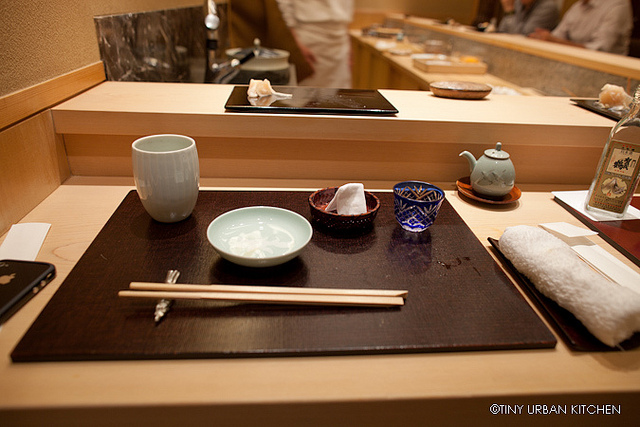
I had read that Mizutani-san is very serious about his craft, and comes off as less friendly to foreigners because he won't really talk to them. My initial impressions seem to confirm those sentiments. The room is quiet even though almost every seat is filled. There appear to be three Japanese diners, another couple from Singapore (who are speaking English), and us.
Mizutani-san hands us our first plate full of several pieces of sashimi without saying a word. He almost acts as if we do not exist. Perhaps it's true. The experience is so different when you can’t interact with the chef.
The next time he comes over, I muster up as much courage as I could, and sheepishly ask in my broken Japanese, “kore wa nan desu ka?” (what is this?) A tiny smile flickers across his face as he looks at me and slowly said, “ma-gu-ro.”
On that same plate, we sample ikura (salmon roe) from Hokkaido served in a bowl. The eggs are firm, bursting with a slightly salty yet almost sweet, rich liquid. Hirame (fluke), a light, white fish is chewy and just slightly stringy. Abalone appears again, which is characteristically chewy yet sweet. At this point, I start to realize that all sushi restaurants get their fish from Tsukiji, which means most restaurants will have pretty similar offerings.
Saba (mackerel), one of my favorites, is deliciously fatty, rich, full of flavor. I've mentioned before that I absolutly love ika (squid) sashimi in Japan. The ika here is beautifully creamy yet has a nice al dente texture to it.
We washed all of this down with a few bottles of Kirin beer.
I relentlessly express interest in what I am eating, constantly peppering him with questions.
Occasionally I won't understand his Japanese, which causes him to ask his assistant to bring out a book with English words and pictures so he can show us. As the evening continues, the atmosphere relaxes and we start to chat a bit with the people around us.
The couple from Singapore speak English, so we make some light conversation with them. A Japanese guy sitting a few seats away actually speaks excellent English, and starts helping me out with translations when Mizutani-san and I get into binds.
The sashimi courses end, and we move onto sushi.
We begin with akagai (bloody clam), which is toothsome and slightly sweet.
But honestly, at this point I'm almost not noticing the clam. Why?
I have just tried Mizutani-san's sushi rice for the first time.
This is truly the most incredible rice I've ever had.
Mizutani-san is seriously a master at making rice and slicing fish. Each piece of nigiri has an absolutely perfect ratio of fish to rice. The temperature of the fish and rice is precise and accurate; and the texture of the rice is phenomenal - perfectly "vinegar-ed", beautifully al dente, and just the right temperature. You can taste each individual grain of rice, which is crucial (no mushy rice here!).
Kohada, gizzard shad, comes next followed by tuna (maguro). Unlike the typical red maguro, this one is slightly pink and rich full of flavor. In Japan, I actually prefer tuna over salmon! We continued down the line of tuna fatty-ness, trying chutoro next (tuna belly), which has noticeably more fat and a much richer taste. Finally, the mini-series ends with otoro (super fatty tuna belly), which is absolutely incredible. It really seems to just melt in your mouth!
Aoyagi (red clam) then appears, followed by kobashiya, which looks like a bunch of mini bay scallops in a gunkan (warship) roll form. The few times I've tried mirugai (geoduck) in America, I haven't liked it because I found it to be stinky. Here, however, it is chewy and sweet, not the least bit stinky.
I get more comfortable with my Japanese, and soon, Mizutani-san and I are chatting about all types of topics (sometimes with the help of Mr. Japanese Translator Man!).
He tells me he has been making sushi for 50 years (!!!), and jokingly asks me whether I was born yet when he started making sushi. He used to work at Sushi Jiro (a well revered legendary sushi institution also holding 3 Michelin Stars) in Yokohama for 5 years before coming to Ginza to start his own place.
At first, he had a space in the basement, but just last year, he finally was able to move to this 9th floor location. Though the place has no windows, he still likes being high up compared to being in the basement.
"In Ginza, there is no Jiro, so Mizutani reigns," he half jokingly asserts.
Mizutani-san is super friendly now as he continues to churn out expertly constructed, gorgeous sushi - one at a time.
We continue our sampling feast. We try Aji (horse mackerel), a white fish that I see over and over at Tokyo sushi shops. Kuruma ebi (fresh, cooked prawn) is good but (shockingly), we think we actually prefer the one at Kyubey! This one was more cooked than I would have liked. Maybe something to do with cooking live shrimp right before serving? . . . . 🙁
Uni (sea urchin) is creamy, delicious, just like at all the other places. Anago (salt water eel) is not as fatty as unagi (freshwater eel), but is soft, tender, and flavorful like unagi.
Finally, near the end, he hands us a simple tekkamaki (tuna roll). While at any other restaurant I would consider not eating this "filler" type ending course, here I love his rice so much I almost don't care what is inside. I savor every single bite of the tuna roll.
We end with tamago (sweet egg omelet). This is fantastic - soft, delicate, and custard-like! It reminds me of the tamago from Sushi Kanesaka, the only other place with such perfect eggs.
I tell Mizutani that his food is incredible, and that I have been trying to book a reservation here for over 2 years.
He sighs and tells me, "it used to be that you had to book at least two months in advance to reserve one of the eight seats in this restaurant. However, ever since the earthquake, foreigners stopped coming."
Suddenly, Mizutani hollars for his wife, "Obasan!" Before you know it, he has asked her to let us get out our cameras. Bryan and I are in shock - is he going to let us take a photo? The meal is already over, but he lets us take a coveted photo with him.
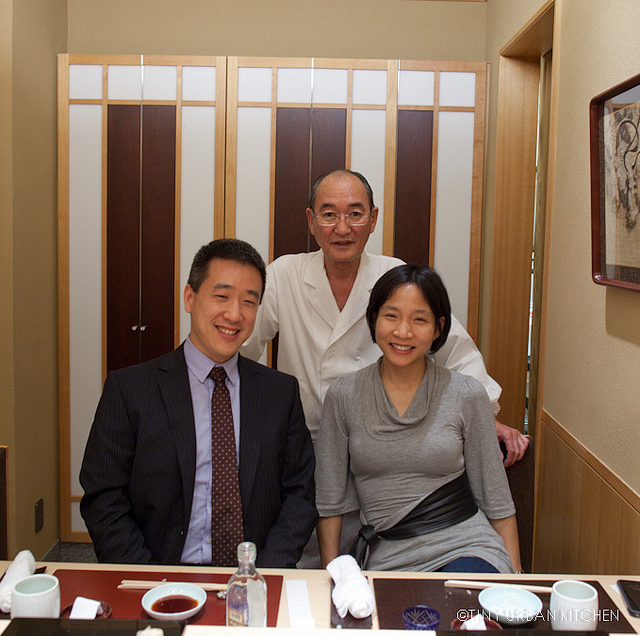
Is this the best sushi you’ve ever had?
It’s hard to say. At this point, I’m seriously having a hard time distinguishing all these Michelin stars. We are still huge fans of Kyubey, and although it lost the one star that it had, honestly, we still think it’s very, very good.
The nice thing about going to Sushi Miztani is that you are guaranteed to get the MAN HIMSELF when you dine there. Other places, like Sushi Kanesaka (2 stars) and Kyubey employ other sushi chefs. You may not necessary get the man himself when you dine there. Kyubey is such a huge operation, odds are you won’t ever get the same chef twice unless if you request someone.
Mizutani-san goes to Tsukiji fish market every morning (only a 10 minute walk away) to scope out the best fish for the day. The sushi at Sushi Mizutani is incredible and definitely compete with the best sushi we’ve ever had.
There’s nothing particularly fancy or inventive about what we ate. Most of our courses consisted of a very fresh piece of seafood either on its own with just a slight bit of sauce (sashimi), or over a perfectly formed ball of rice (sushi). At a place like this, it’s all about the quality of the fish and the precise execution of the numerous sushi skills needed to assemble that perfect, blissful bite (still thinking about that oh-so-perfect sushi rice . . .).
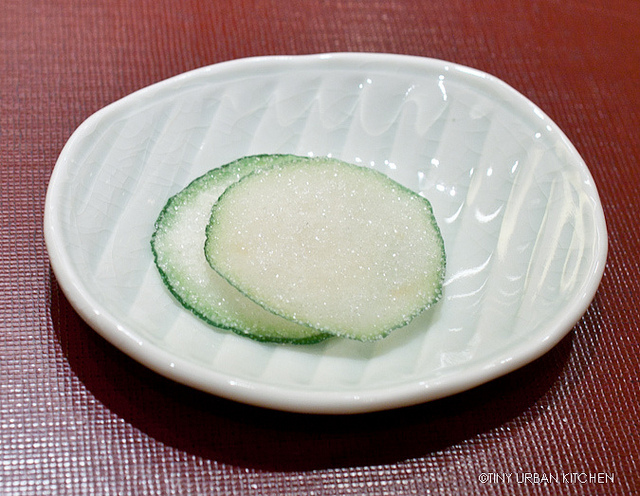
The free sugared gourd slices that Mizutani-san gives to Bryan to enjoy while waiting for me to come back from our second ATM trip
Cash only??
This is something we didn’t know, but Sushi Mizutani is cash only. You may think that it’s ridiculous that a restaurant that charges over $200/head would be a cash only type restaurant. Mizutani’s wife tried to explain their reasons. Credit card companies charge a 10% commission. This really starts to add up when meals start hovering around $500 USD and up. She said they didn’t want to increase the prices even more since the meals are already so expensive. Thankfully, there is an ATM that accepts international cards (not all of them do!) inside a 7-11 down the street. In our case, one of the assistant chefs escorted us to the ATM and back. Interestingly, the ATM only lets you take out around 20,000 yen in one sitting, so Bryan and I had to take a trip each to make sure we had enough cash! Lesson learned. If you’re coming to Sushi Mizutani, come with enough cash!
If you really, really enjoy top quality sushi made my one of the most expert hands around, Sushi Mizutani is definitely worth the visit. His rice alone is second-to-none. It goes without saying that the fish is incredible. If you don't speak any Japanese, I do think it would be beneficial to go with someone who speaks. It really makes the experience much more enjoyable.
This ends the Post Quake Japan Series based on most recent trip to Japan a few months ago. It was truly an incredible trip. The Japanese people and culture continue to fascinate me and I am continually amazed at their resilience following such an awful tragedy.
Can't wait to go back!
RELATED POSTS
2011 Japan Trip
Post Quake Japan
Kago
Daisan Harumi
Tempura Kondo
Sushi Mitani
Inakaya
Aronia de Takazawa
2010 Japan Trip
Part 1: Kappabashi Dori
Part 2: Tapas Molecular Bar
Part 3: Suzuran
Part 4: Matcha and Azuki Breads
Part 5: Masamoto Tsukiji Knives
Part 6: Maisen (Tonkatsu)
Part 7: Snacking in Japan
Part 8: Sushi Kanesaka
2009 Japan Trip
Everything I Learned About Sushi I Learned from My Mom . . . . And Kyubei
Seryna (Kobe Beef Shabu Shabu)
Sometaro (okonomiyaki)
Maisen (tonkatsu)
Kyubey (sushi)
Suzuran (ramen)
All Rights Reserved








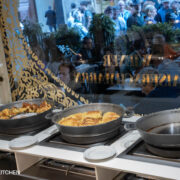
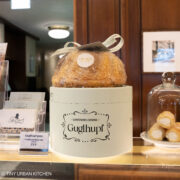
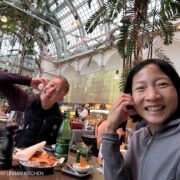
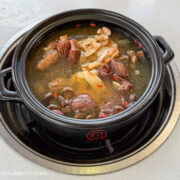

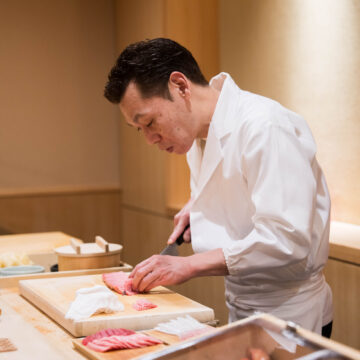
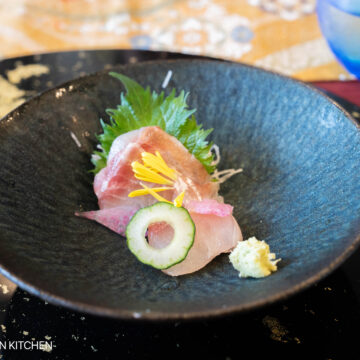
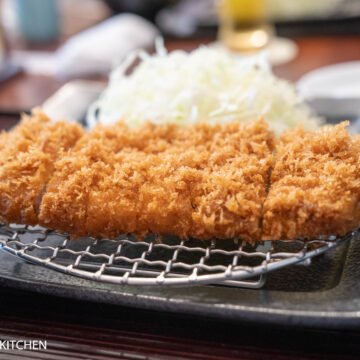
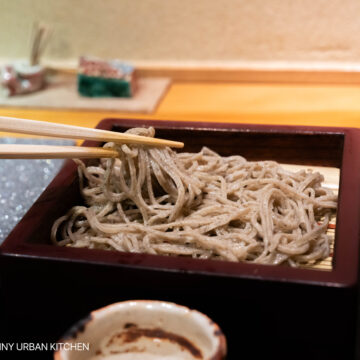
[…] custard). We always compare any restaurant’s tamago with our gold standard: the tamago at Sushi Mizutani and Sukiyabashi Jiro (both are simply divine). According to Bryan’s notes, this particular […]